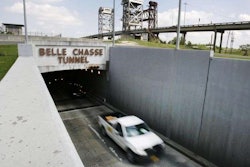 One of the nation’s deadliest infrastructure failures was on Aug. 1, 2007, when a gusset plate failed on the 8-lane I-35W bridge in Minneapolis. The collapse killed 13 people and injured 145. Photo courtesy of National Transportation Safety Board.
One of the nation’s deadliest infrastructure failures was on Aug. 1, 2007, when a gusset plate failed on the 8-lane I-35W bridge in Minneapolis. The collapse killed 13 people and injured 145. Photo courtesy of National Transportation Safety Board.A broken budget process must be fixed if Congress is going to finally confront and fix the nation’s ailing infrastructure, according to a new statement released by the American Society of Civil Engineers.
“For decades, Congress has repeatedly failed to pass a budget on time, speeding toward budget deadlines as if we have miles of roadway ahead of us, when in reality, we’re laying down roadway as we are driving over it. This has only led to repeated crises—our government has shut down 20 times since 1976,” ASCE staff members point out.
“If this were a bridge, we’d rate it as structurally deficient,”
The statement, written on behalf of the staff by Brian Pallasch, managing director of ASCE’s Government Relations and Infrastructure Initiatives, says Congress has failed to confront and correct the real problem: fixing the budget.

“I view this fundamentally as an engineering issue, and engineering problems are solvable. With enough hard work and smart planning, engineers can reinforce a levee, repair a bridge, or build a road that stands the test of time. Legislative problems are solvable, too, so long as you work together to fix them,” Pallasch writes in the statement posted March 1 on ASCE’s website.
He tells of partnering with a bipartisan coalition of budget and policy experts to create a blueprint for what these reforms could and should look like.
“Our group included government affairs professionals like myself representing veterans, millennials, children, universities, businesses, and so many other groups.”
At the end of February, they delivered that plan, the Convergence Building a Better Budget Process Project, which outlines these steps:
- Create a budget action plan—negotiated by the president and Congress at the beginning of a new session and enacted into law—to synchronize the budget cycle with the electoral cycle and to change expectations for the process. The plan would make certain key fiscal decisions – setting discretionary funding levels and adjusting the debt limit, for example – for a two-year period.
- Issue a fiscal ‘State of the Nation Report’, published every four years at a key point in the national election cycle, to make the federal budget more accessible to the American public and elevate the discourse about the country’s finances.
- Conduct a review of the performance of portfolios of federal programs that involve long-term or inter-generational commitments (such as retirement security, health coverage, education or national security). This review conducted by Congress, through the Government Accountability Office, would reinforce the importance of the long-term effects of budget decisions.
- Strengthen the budget committees by revising the membership rules and assigning responsibility to create new expectations for the budget process so that Congress and the public can expect more timely action on budget decisions.
- Invest in agencies that support the congressional budget process, including the Congressional Budget Office (CBO) and the Joint Committee on Taxation (JCT), so these institutions can continue to provide high-quality and independent information the nation relies on in making budgetary choices.
 FWHA photo
FWHA photo“We’ve drawn up plans to fix it, but now it’s up to Congress to act. I hope the members of the new select committee tasked with overhauling the budget process takes action,” Pallasch urges.
“Failing to confront a problem over and over just makes it worse. That’s the thing about deferred maintenance—eventually it catches up to you.”
The nation’s attention was drawn to the problem of crumbling infrastructure in a dramatic way nearly 11 years ago in Minneapolis.
One of the nation’s most deadly infrastructure failures came at 6:05 p.m. on Aug. 1, 2007 in Minneapolis, when the I-35W bridge over the Mississippi collapsed. An investigation centered on a gusset plate that failed. The eight-lane bridge was bearing typical vehicular traffic plus added weight of heavy equipment and materials during roadwork on the 1,907-foot-long bridge. Thirteen people died. Another 145 were injured.
(To see the National Transportation Safety Board’s detailed report on the collapse, click here.)
Though a long public outcry followed the catastrophe, along with hundreds of bridge inspections coast to coast, many say inadequate funding continues for the nation’s infrastructure.
ASCE joins numerous other groups, including the National Asphalt Pavement Association, in continuing to call on Congress to provide more infrastructure funding as a national priority. And now, through it’s newly released statement, ASCE stresses that the Congressional budget process must be fixed in order for that to happen.
The convergence group’s full report can be found here.












